This is going to be a blog in two parts, because there is just so much to describe and discuss. Part 1 is mostly about my final preparation for Project 4 (Layers) and a visit to Clitheroe’s Platform Gallery. Part 2 will discuss the HNC July Study Weekend: the group critique, the lectures and workshops. There will also be a preview of my forthcoming residency at Farfield Mill in Cumbria – as a composer and weaver.
So the last study weekend of the first year of the HNC in Woven Textile Design has been and gone. I finished my fourth project (Layers) in time to present the outcome at the Group Critique last Saturday. In fact, I had it finished with a day or two to spare by committing myself to show it to a ‘critical friend’. Every creative artist should have at least one ‘critical friend’ , someone who can be trusted to be observant and honest, but not destructive or dismissive. I’ve appropriated this term from my time as a governor of my children’s school, a role that depends on such critical friendship being offered to the teaching staff. My valuable critical friend said very little, but as she gently looked through my work I seemed to know instinctively where I hadn’t hit the mark. But I step ahead of myself. Let’s start with those swatches woven on the ambitious double weave warp I discussed in my previous blog.
Over three days I managed to weave four swatches that, with my two two-colour double weave ‘bags’, just met the project requirement. The warp behaved itself very well, and there was only breakage, which I successfully repaired. I finalised the designs of the weft before I began weaving, and only parted a little from my original intentions when I discovered I needed to be able to weave both top and bottom cloths together. I had two treadles free in the tie-up and so was able to raise shafts 1 and 3 from the bottom and shafts 2 and 4 from the top. The pattern this revealed I felt added immeasurably to the weave (see the top and bottom layer – in light blue – of the illustration below).
You’ll see from the photos of the swatches that the colour sequence of the weft was pretty much the same across all four pieces. The differences included: a swatch with sections of Brooks Bouquet Lace on the top of the second swatch; a swatch almost entirely woven to highlight the pattern created by weaving both cloths together; the addition of linen and cotton threads wrapped around selected chenille wefts. Along with keeping the chenille panels separate from each other with blocks of wool and acrylic ‘blues and greys’, the use of orange, lilac, light blue and yellow linen and cotton threads really brought to life the rather dark tones of the chenille yarns I’d chosen.
When I got to the fourth swatch I had decided to make it so that the two cloths would be joined only on the left hand side, so as to be able to open the cloths out as one fabric. I took great care with the ‘open’ side selvedge, and was pleased with the result. However, when I came to take it off the loom and divide the selvedges I realised I’d ‘closed’ the cloth at both ends by weaving top and bottom cloths together, so I was a little reticent to cut and machine-stitch the top and bottom ends.
All in all I found weaving double cloth requires intense concentration – if there is the likelihood of any interruption then it’s a lost cause. It can be so difficult to remember when you are in the sequence of things!
After the weaving of course comes the creation of the sketchbook and the technical notes or ‘loom tickets’. For Project 3 on Blocks I felt I’d started to make progress with the sketchbook – detailing visual realisation and design development. My sketchbook is not one that gradually collects and assembles material as I’ve gone along. It is more of a compilation of ideas and existing work that I bring together, sometimes developing, fleshing out, re-doing in a different format or media before organising carefully in a sensible sequence. I noticed when looking through my HNC colleagues’ sketchbooks that this is common practice with some of them too. It generally makes for a more satisfying production. However, those students who do present the warts and all sketchbook do end up with something that can be both fascinating and revealing. I notice there is a tendency in such sketchbooks to be more self-critical and include valuable evaluations. The design development process also tends to flow seamlessly from the visual realisation recorded if approach in this way. For me, having got the measure of the compilation approach, I’m planning for Project 5 to start a new sketchbook and make it more like a progressive diary of observation and development.
When my tutor discussed my sketchbook with me I was intrigued by her enthusiasm for the excerpts from my little diary of text and images I’d kept during my week in North Wales, a diary that records my stay at the location upon which I’d based my theme for the project title Layers. She was also enthusiastic about some of the computer manipulations I’d made from my own paintings of sea and sky. I’d experimented with making tessellations from photos and, most significantly, revealing ‘unknown colours’ from digital images of sea and skyscapes through lowering the image resolution.
In the past the loom ticket has been a final hurdle that I’m ashamed to say I have often fallen at. I’m not comfortable with keeping detailed notes as I weave, but in my work on the dobby loom at college I devised a method for recording weft picks as I went along. It was pretty unorthodox, but it worked! For project 4 I felt it necessary to get my act together and produce a loom ticket like many of my colleagues tend to do. I created a sheet in the Excel application and did the business, albeit at the last moment (just before my final tutorial). I received some valuable advice from my tutor about notating double weave information and now feel more inclined to get the loom ticket in place after finishing each swatch.
Along the way I did acquire a book that seems more and more valuable to me in this area of recording and drafting. It is The Complete Book of Drafting by Madelyn van der Hooght. There’s a lovely introduction, in which the author gently describes how easy it is to try and weave something that has a design and process you don’t understand. ‘Everything in weaving is so simple after you understand it, but before you do, it seems so hard’. The author goes on:’ Remind yourself as you struggle with concepts that feel complicated, they are simpler than they seem. If you persevere, you’ll learn the special joy of sudden understanding – which will bring a special joy to me’. I can vouch for that.
I think the majority of my HNC colleagues had really struggled to understand double weave, and there seemed to be quite a lot of ‘painting by numbers’ going on. Hand on heart I think I can say I understand double weave, but blocks in double weave I have yet to be able to ‘do’ properly on the loom. All that reading I did during the early stages of the project, particularly the book Double Weave by Palmy Weigle, really paid off.
After nervously showing my Project 4 work to my critical friend (see above) she kindly took me off to look at an exhibition that ties in with research she is undertaking on the influence of gardens on textile design. We drove out of Yorkshire into Lancashire (Elvis Costello on the stereo! – a novel experience as I usually drive in silence), and almost in the shadow of Pendle Hill (which I’d never seen) we arrived at the Platform Gallery in Clitheroe. This lovely gallery (a former railway station) describes itself as ‘the platform for craft in Lancashire’, and rightly so. The current exhibition is titled Botanic Gardens and brings together 24 artists and crafters. Two textile artists really caught my attention: Helen Slinger and Norah Ball. Helen’s work is ‘inspired by her photographs of plants and trees, selecting images for their qualities of light and shade, line and form’. I particularly liked her use of digital printing on fabric enhanced by some very fine embroidery, in a sequence of restrained garden pictures in a single shade of green. Norah Ball’s work was part of a supporting exhibition by Preston Threads called Threads of Nature. She showed three large, adventurous woven textile hangings. I was very struck by these pieces and recently contacted Norah to ask if I might write about her work, which, as you’ll discover later in this blog, has some relevance to the next project I’m undertaking at Bradford. She most kindly replied to my e-mail enquiry with this description.
The warp for all 3 is a nylon from Lurex Co called Nigel. I had no bother with it at all – the warps were just prepared on a warping board as I don’t have sectional warping at the moment. The weft in the first piece (Morning Mushrooms) is the same fibre with varied beat depending on how much and where I wanted it to move once off the loom. The other 2 pieces combined the nylon weft and a variety of natural yarns to achieve the effect I was looking for. I used several structures in the natural yarns which are more obvious on close inspection and add interest for anyone who knows about these things. The use of leno in the nylon helped stabilize the work. After weaving, one piece was left natural. The other 2 were stitched (in one case) painted (in one case) and dyed (in both cases) using wax resist and fibre reactive dyes.
Norah is clearly a textile artist who combines many different techniques and materials. She’s interested in using recycled materials, which just happens to be the theme of my next HNC project. She says: Much of what I know is self taught supplemented by judicious selection of courses. I started out with a rudimentary list of ‘must-do’s’ to expand my knowledge. This means that I can readily combine all sorts of things from design, photography/photo manipulation, felt, weave, paint etc etc as I see fit for the subject I’m working with. I think this is a really ambitious (and probably necessary) personal approach, and one that I so admire. Norah, like me, has a high regard for weaver Sue Lawty and has had the good fortune to attended her workshops and be an assistant on a number of her celebrated pieces (like the Bankfield commission Terra featured on these pages earlier this year). Although I’m currently jumping through the necessary hoops of woven textile design and making, my heart is really more in the area of the experimental and fine art end of textiles – more Sue Lawty than Margo Selby. Norah’s approach is possibly more extreme – her experience with textiles really crosses over into making in other media. She certainly doesn’t want to pigeonhole herself into any particular category. Rather refreshing I’d say!
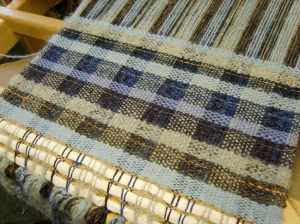
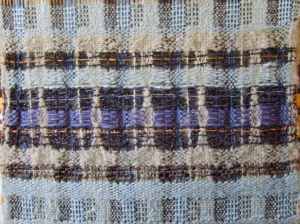
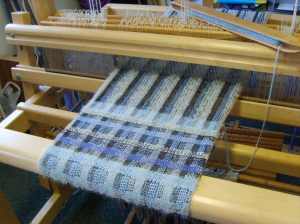
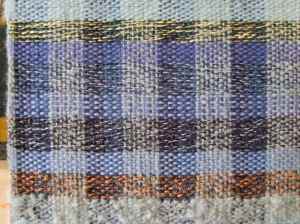
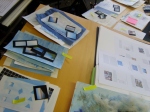
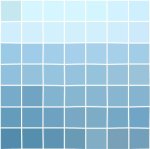
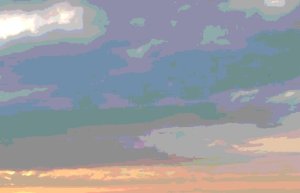
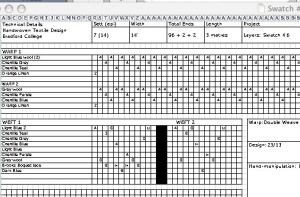
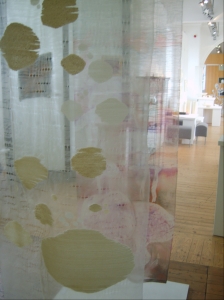
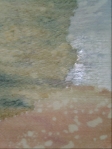
July 24, 2009 at 3:20 pm |
Your weaving’s looking good. I like the idea of having a “critical friend”. I’m fortunate to live with one… we met at pottery classes many years ago and having been discussing aesthetics ever since. I find it is of immense value to have someone to bring a different viewpoint and analyse / assess / debate my work.
I like the look of the low resolution technique for looking at how the colours work, because doing it that way you can still look at how the proportions of each colour are working and the interaction between them, just abstracting the colours from a photo loses these things.
Will you be exploring other weaving things over the summer break, or is there a project to take in at the start of next term?
July 25, 2009 at 6:01 pm |
As always, I thoroughly enjoyed this post. I understand the need for total concentration when doing double weave! It is very easy to get confused and not know where you are at. My favorite swatch was #3. I noticed you were weaving with a rug shuttle instead of a regular shuttle. I’m curious as to why.
I used to enjoy playing with reducing colors in PaintShopPro. But then I stopped because I wanted to pick the colors myself!
Your comments on sketch books were very interesting. I do not yet keep a sketchbook (remember, I keep an electronic sketchbook) for a specific project, though I think I may start that for my next project. I think it may be more useful than just the written word alone.And I would not remove the warts. Then it would go in my computer folder for the project. My sketchbook that I am currently keeping is what might be more generalized inspiration. Ideas that don’t yet belong anywhere, might not ever belong anywhere. I have not been keeping it lately because my thinking/ideas have been focused onto my next project. I think I will start a specific e-sketchbook for this project.
Thank you for the photo of the Excel documentation.
Thank you for sharing Norah Ball. I have often thought of combine other textile techniques with weaving, techniques such as embroidery (I have done both hand and machine embroidery), using dye or paint on a finished piece, in other words, blending surface-design techniques into weaving. But that is for my next incarnation………. Surely I will get another chance at this….???? (grin!)
October 15, 2009 at 3:09 pm |
Hi Nigel
I periodically read your blog about life at Bradford! I graduated with my HNC in 2004 with loads of very fond memories.
Keep working at the sketchbooks and don’t be put off by those colleagues who produce huge ones! Mine where always much smaller, in content, but with loads of pertinent self comments to myself. I always worried that I’d not done enough, but Andrea always reassured me that what I’d done was very relevant and encouraged the note writing! I still work in the same way, art work with conversational notes with myself, design development with conversations, swatches and loom tickets as I go!
I do find that I can go back to a previous sketchbook and find more to do and often keep my current one out on my desk so that I can see it when passing and find that ideas will come to me, I even go back and add artwork that pops into my head which leads to more design development.
Best wishes
Alison
November 24, 2009 at 11:37 am |
Great Article , I thought it was marvelous
I look ahead to more interesting postings like this one. Does This Blog have a subscription I can subscribe to for new posts?